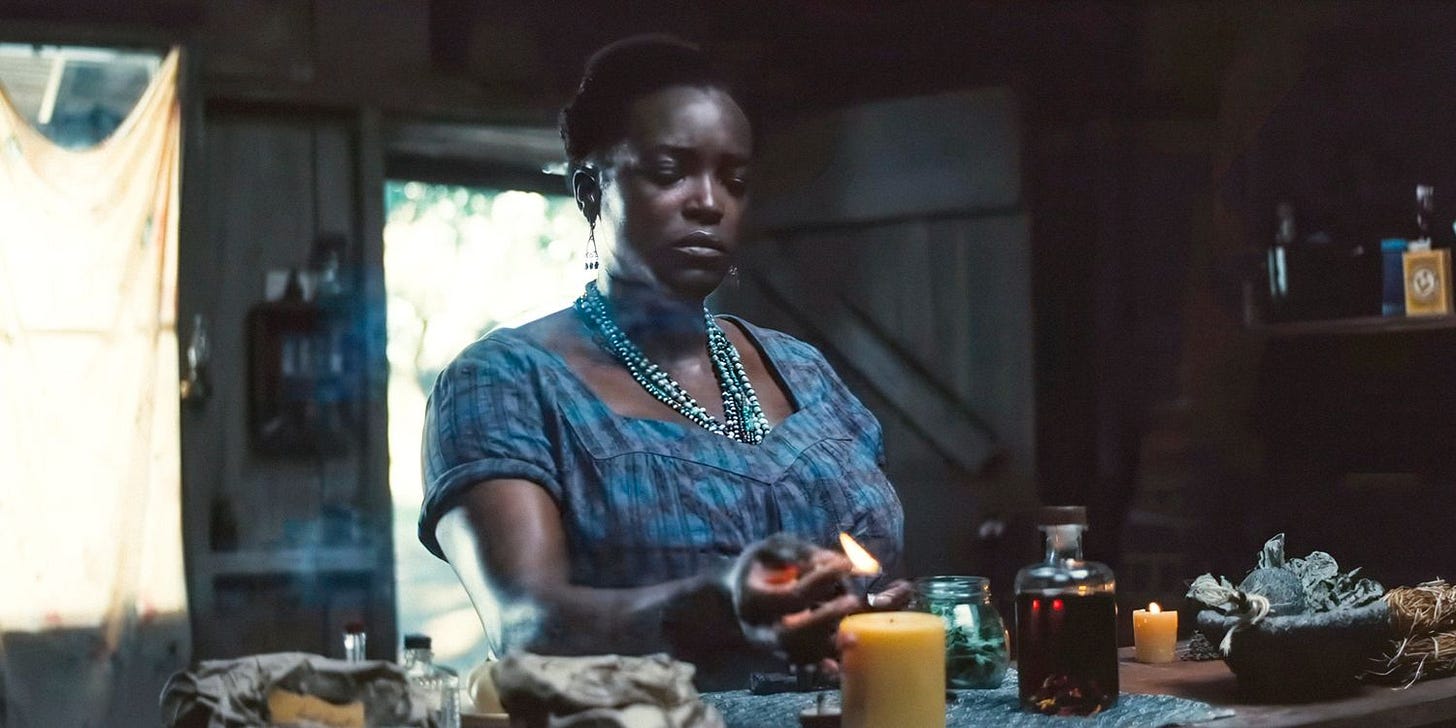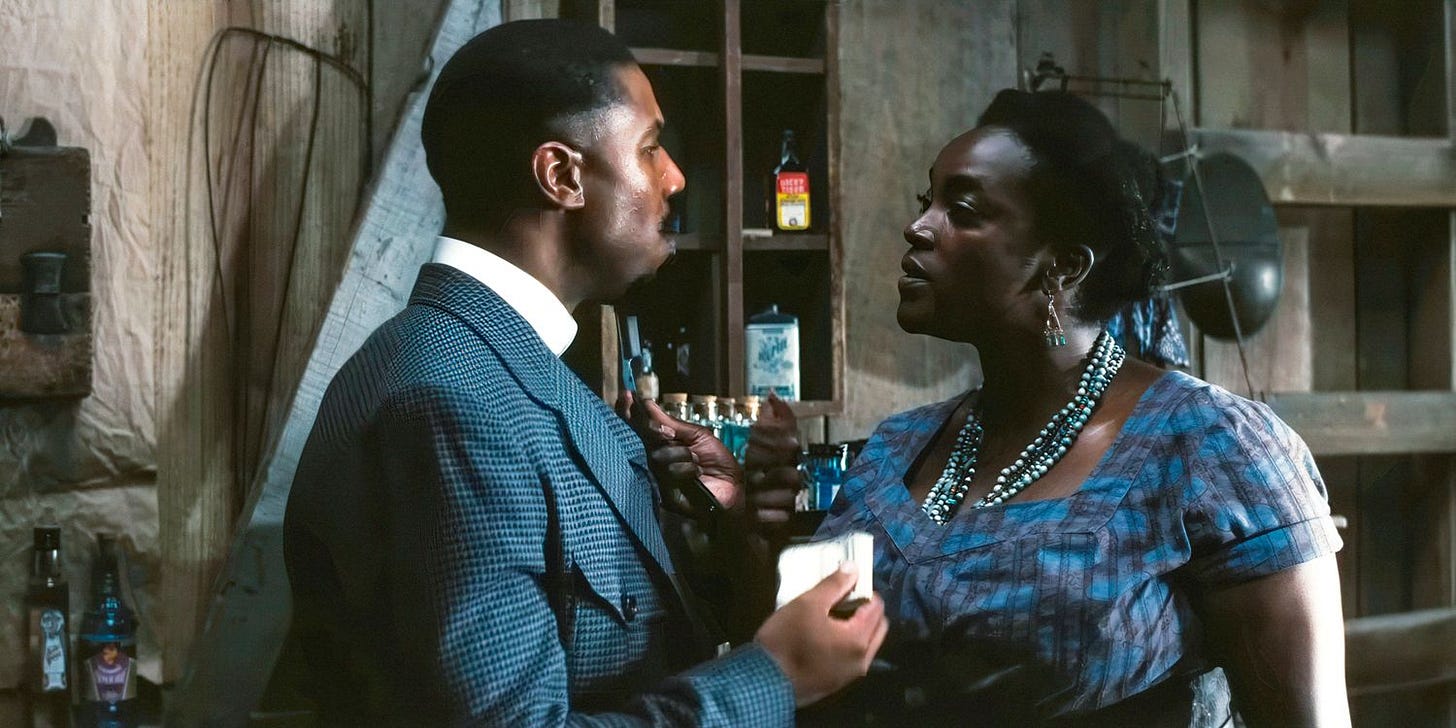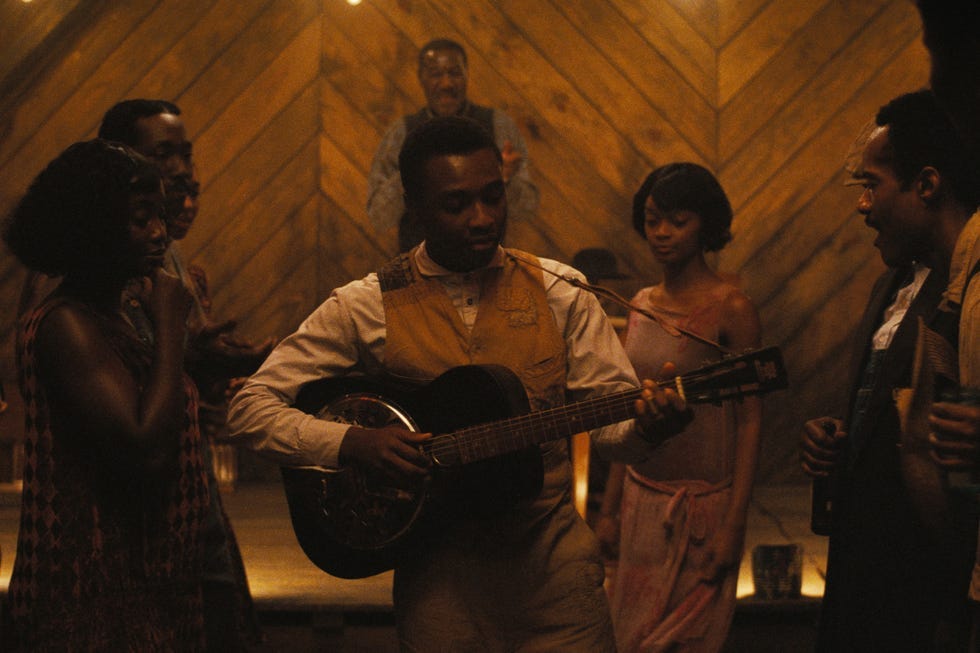Posted initially on Threads. Revised.
Annie, played by the hauntingly talented Wunmi Mosaku, dressed in blue, was an homage to the ways blue has been used as a form of protection in Gullah Geechee culture and some lineages of Hoodoo. But it was also a reference to the phrase “devil in the blue dress,” which makes sense. Hoodoo is treated as evil, even though it has continued to save lives. She lived in a wooden shack and wasn’t fooled by riches or attached to the material world like the others.
Annie’s most prized possession was her body, through which she birthed a child that was also no longer in the material world. Her body, when we meet Annie, is clad in varying shades of blue. Both her housedress and her beaded necklace are blue, to keep away the haints. She even originally misidentifies the vampires as haints. To learn more about blues and Blackness, I recommend Imani Perry’s Black in Blues: How A Color Tells the Story of My People.
Okay, back to Annie because she was my favorite character in the film…
Hoodoo is treated as evil, even though it has continued to save lives.
Annie also wasn’t fooled by Smoke’s reputation or public-facing persona. She saw through him, down to the little black boy tucked deep within. Which, aside from the profound grief of losing a child, is the other reason why it was difficult for him to return. He couldn’t face Annie. As hot as that sex scene was, when she faces him directly, he takes her from behind. (Can we get a think piece on Black masculinity, grief, and the shame of needing love? Smoke went SEVEN years without the person he needed most.)
Annie was the Hoodoo practitioner who saved everyone from the eternal damnation (exploitation?) of both colonialism AND vampirism. Vampirism is deriving pleasure and vitality from draining another of their life force. The Klansmen were vampires, too.
Annie was also the reason Sammie’s father, Jedidiah (played by the incomparable Saul Williams), was able to live to preach another sermon about sinners. The vampires would have decimated the entire town! Her knowledge of the spiritual properties of herbs, roots, myths, and legends—things often treated as fiction or “woo-woo”—and her willingness to know her fate ahead of time yet still choose it are what made her the hero. Plus, did anyone notice that Jedidiah did not react to the monstrous gashes on Sammie’s face or his mangled guitar? The man knew something!
Vampirism is deriving pleasure and vitality from draining another of their life force. The Klansmen were vampires, too.
And can we talk about the juke joint scene??? Everything was happening at the right time, and everyone contributed to it. Had the Chous not agreed to make the sign and support, had Delta Slim not agreed to perform, had Annie not agreed to event coordination, had Cornbread not agreed to security… the conditions would not have been set for Sammie to do what he did. The veil is pierced by Black joy (which is Black sorrow—or Blues—transformed), and it was a collective effort. Sammie had played earlier in the film, but the veil was opened as a result of the high he felt by playing in front of a crowd that responded to him positively. That call-and-response technique is what amplified Sammie’s voice to the Spirit realm.
When his voice pierces the veil (the roof…the roof…the roof was on FIRE), this scene is a visual and sonic depiction of a time collapse. Songs, chanting, dance, music all have this ability, especially drumming. This reflects Quantum Entanglement Theory, which author, attorney, and artist Rasheedah Phillips describes as “entangled particles remain connected…the state of one instantaneously affects the state of another, no matter the distance between the two particles.” This scene also reflects a state of Quantum Superposition, which happens when “a particle exists in multiple states simultaneously until the particle is measured or observed,” according to Phillips in their new book Dismantling the Master’s Clock: On Race, Space, and Time (a book you NEED to read). Cultures and ancestors across time and space were entangled with Sammie’s performance; what he was doing in the present was simultaneously impacting ancient pasts and distant futures. Many Spirits attended the juke joint that night, but only one intended to cause harm.
The veil is pierced by Black joy (which is Black sorrow—or Blues—transformed), and it was a collective effort.
Remmick, the Irish vampire, was the observer, emitting a white gaze that plotted to collapse that Black joy into a particularly sinister reality… justifying it because accessing the portals opened up by Black joy would reunite him with his own ancestors. (Imagine relying on death and separation, thinking it will bring you closer to belonging.) His other justification was that the Klansmen (aka the other vampires) were already planning to kill everyone. Delulu Rimick truly believed he was providing a more meaningful death than the Klansmen. None of the forms of whiteness imagined Black life beyond its utility in a white schema (including Mary’s).
In my mind, Toni Morrison was a governing ancestor of Sinners. The world-building was reminiscent of Medallion in Sula, and Zora also showed out as a governing ancestor, too. I’ve only watched the film once, but I cannot wait to return and return (and return) to discover more of the film’s dimensions.
OH and then Annie’s transformation from blue (in need of protection) to white (ancestral protector) *chef’s kiss*








